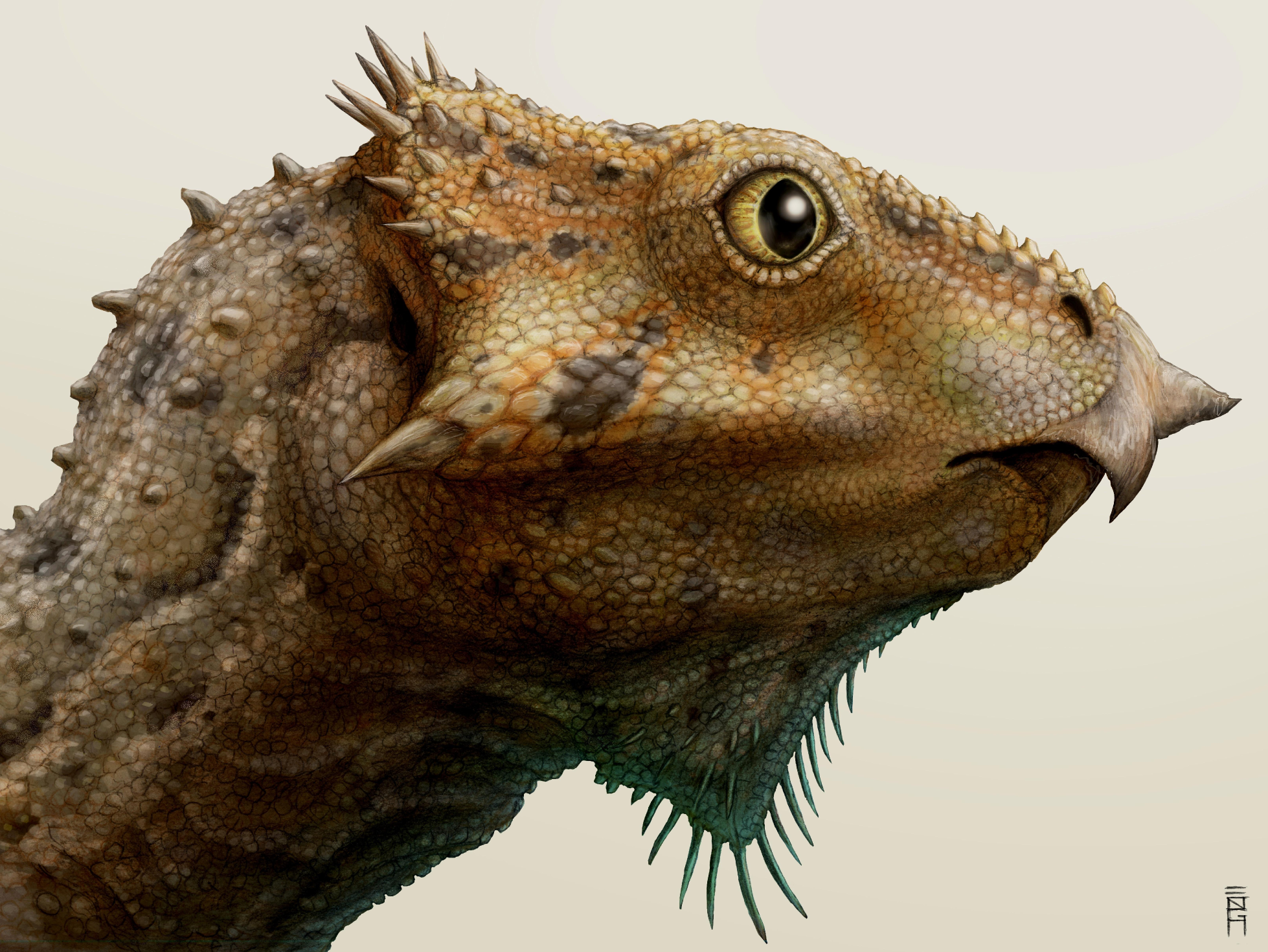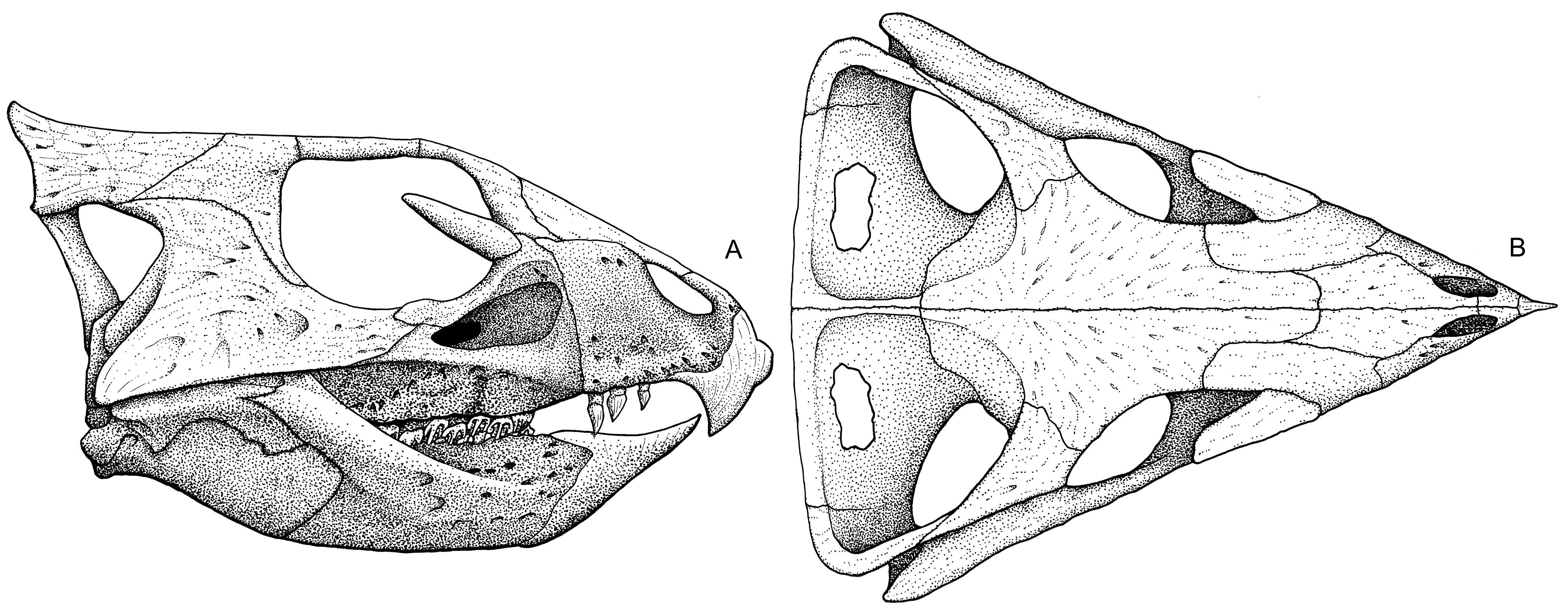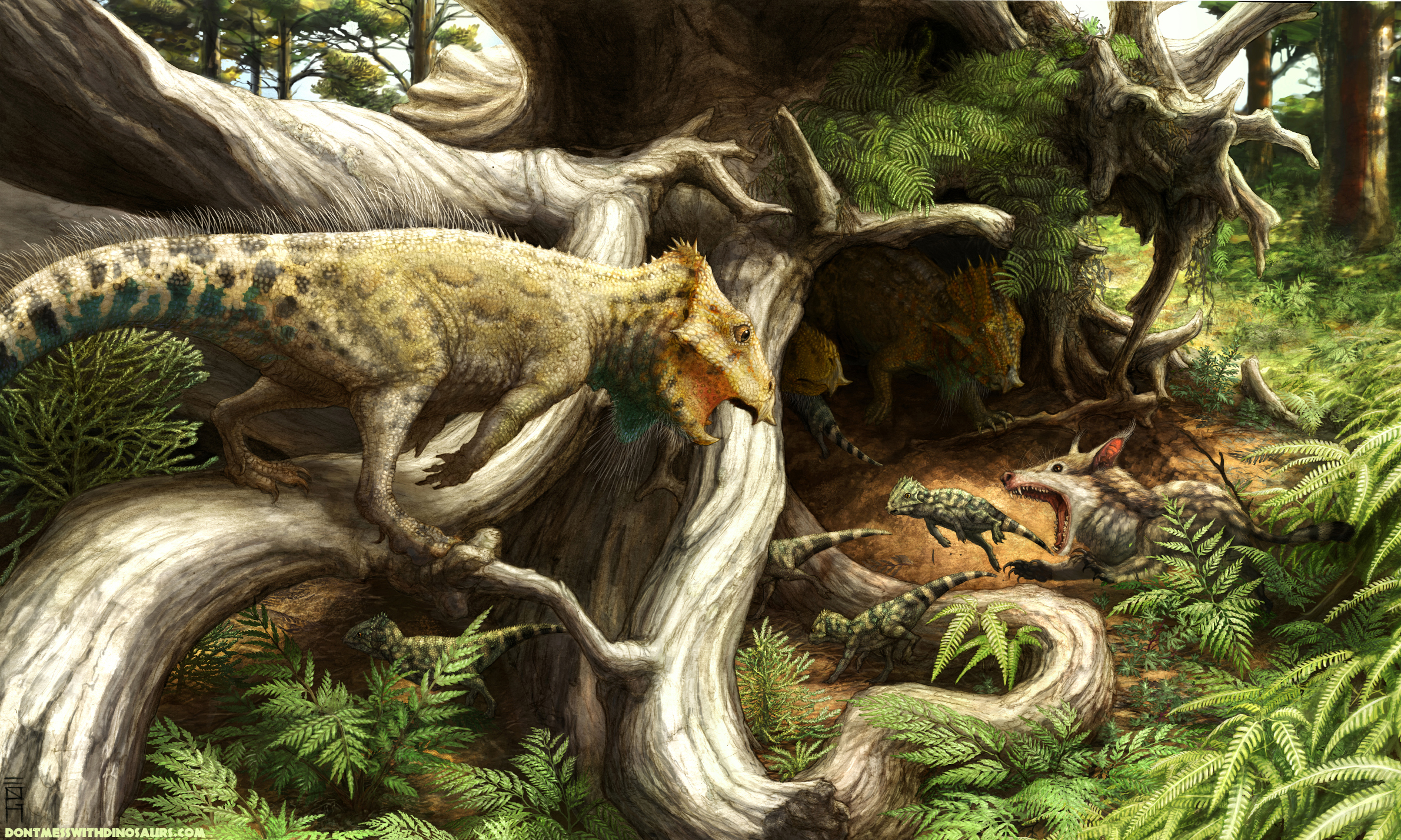Aquilops americanus on:
[Wikipedia]
[Google]
[Amazon]
''Aquilops'' is an early herbivorous
 The skull is 84.2 mm long. The
The skull is 84.2 mm long. The
 In 1997,
In 1997,


 ''Aquilops'' was placed in the
''Aquilops'' was placed in the
The Sam Noble Museum
- Interactive 3d models of ''Aquilops'' skull and dinosaur. {{Taxonbar, from=Q18617035 Ceratopsians Ornithischian genera Early Cretaceous dinosaurs of North America Taxa named by Matt J. Wedel Cloverly fauna Paleontology in Montana Fossil taxa described in 2014
ceratopsian
Ceratopsia or Ceratopia ( or ; Ancient Greek, Greek: "horned faces") is a group of herbivore, herbivorous, beaked dinosaurs that thrived in what are now North America, Europe, and Asia, during the Cretaceous Period (geology), Period, although anc ...
dinosaur
Dinosaurs are a diverse group of reptiles of the clade Dinosauria. They first appeared during the Triassic period, between 243 and 233.23 million years ago (mya), although the exact origin and timing of the evolution of dinosaurs is t ...
dating from the Early Cretaceous
The Early Cretaceous (geochronology, geochronological name) or the Lower Cretaceous (chronostratigraphy, chronostratigraphic name), is the earlier or lower of the two major divisions of the Cretaceous. It is usually considered to stretch from 145& ...
of North America
North America is a continent in the Northern Hemisphere and almost entirely within the Western Hemisphere. It is bordered to the north by the Arctic Ocean, to the east by the Atlantic Ocean, to the southeast by South America and th ...
, approximately 109 million to 104 million years ago. The type species is ''A. americanus''.
Description
 The skull is 84.2 mm long. The
The skull is 84.2 mm long. The holotype
A holotype is a single physical example (or illustration) of an organism, known to have been used when the species (or lower-ranked taxon) was formally described. It is either the single such physical example (or illustration) or one of seve ...
is possibly not from a full-grown individual. A comparison with related species indicates it might have been at 60% of its adult length. Wedel estimated the total body length of ''Aquilops'' at 60 cm and its weight at 1.5 kg.
The authors established some unique traits. The rostral, the bone core of the snout beak, curves downwards and has an arched keel on its top with a bump on the front. In front of the tooth row the upper jaw rim is over its total length concave in side view. The skull opening, the antorbital fenestra
An antorbital fenestra (plural: fenestrae) is an opening in the skull that is in front of the eye sockets. This skull character is largely associated with archosauriforms, first appearing during the Triassic Period. Among extant archosaurs, bird ...
, is twice as long as it is tall and has a pointed rear, below the eye socket.
Discovery and naming
 In 1997,
In 1997, paleontologist
Paleontology (), also spelled palaeontology or palæontology, is the scientific study of life that existed prior to, and sometimes including, the start of the Holocene epoch (roughly 11,700 years before present). It includes the study of fossi ...
Scott Madsen found the single fossil
A fossil (from Classical Latin , ) is any preserved remains, impression, or trace of any once-living thing from a past geological age. Examples include bones, shells, exoskeletons, stone imprints of animals or microbes, objects preserved ...
, a partial skull, in Carbon County in southern Montana
Montana () is a state in the Mountain West division of the Western United States. It is bordered by Idaho to the west, North Dakota and South Dakota to the east, Wyoming to the south, and the Canadian provinces of Alberta, British Columb ...
. While preparing the specimen, at first assumed to be of ''Zephyrosaurus
''Zephyrosaurus'' (meaning "westward wind lizard") is a genus of orodromine ornithischian dinosaur. It is based on a partial skull and postcranial fragments discovered in the Aptian-Albian-age Lower Cretaceous Cloverly Formation of Carbon Count ...
'', he discovered that it was a species new to science.
In 2014 the type species
In zoological nomenclature, a type species (''species typica'') is the species name with which the name of a genus or subgenus is considered to be permanently taxonomically associated, i.e., the species that contains the biological type specim ...
''Aquilops americanus'' was named and described by Andrew Farke
Andrew is the English form of a given name common in many countries. In the 1990s, it was among the top ten most popular names given to boys in English-speaking countries. "Andrew" is frequently shortened to "Andy" or "Drew". The word is derived ...
, W. Desmond Maxwell, Richard L. Cifelli, and Matt J. Wedel. The generic name is derived from Latin
Latin (, or , ) is a classical language belonging to the Italic languages, Italic branch of the Indo-European languages. Latin was originally a dialect spoken in the lower Tiber area (then known as Latium) around present-day Rome, but through ...
''aquila'', "eagle", and Greek ὤψ, ''ops'', "face", in reference to the beaked snout. The specific name ''americanus'' refers to the fact that the species represents the first unequivocal very basal neoceratopsian found in America.
The holotype
A holotype is a single physical example (or illustration) of an organism, known to have been used when the species (or lower-ranked taxon) was formally described. It is either the single such physical example (or illustration) or one of seve ...
, OMNH 34557, was found in a layer of the Cloverly Formation
The Cloverly Formation is a geological formation of Early and Late Cretaceous age (Valanginian to Cenomanian stage) that is present in parts of Montana, Wyoming, Colorado and Utah in the western United States. It was named for a post office on th ...
, dating from the middle-late Albian
The Albian is both an age of the geologic timescale and a stage in the stratigraphic column. It is the youngest or uppermost subdivision of the Early/Lower Cretaceous Epoch/ Series. Its approximate time range is 113.0 ± 1.0 Ma to 100.5 ± 0 ...
. It consists of a skull with lower jaws, of a subadult individual. The rear of the head and the palate are the main lacking parts. The specimen was found during a 1997 expedition supported by the National Geographic Society and directed by Cifelli.
Classification


Neoceratopsia
Ceratopsia or Ceratopia ( or ; Greek: "horned faces") is a group of herbivorous, beaked dinosaurs that thrived in what are now North America, Europe, and Asia, during the Cretaceous Period, although ancestral forms lived earlier, in the Jurassic ...
. A cladistic
Cladistics (; ) is an approach to biological classification in which organisms are categorized in groups ("clades") based on hypotheses of most recent common ancestry. The evidence for hypothesized relationships is typically shared derived char ...
analysis showed that it was positioned rather basal, below ''Leptoceratops
''Leptoceratops'' (meaning 'Thin-horned face' and derived from Greek ''lepto-/λεπτο-'' meaning 'small', 'insignificant', 'slender', 'meagre' or 'lean', ''kerat-/κερατ-'' meaning 'horn' and ''-ops/ωψ'' meaning face), is a genus of l ...
'' in the evolutionary tree, with only '' Liaoceratops'' being more basal. A more derived position, e.g. as a leptoceratopsid or a protoceratopsid, was less likely; it was improbable that it was a ceratopsoid. The fact that the holotype was a subadult might have distorted these results because juvenile individuals often show basal traits. However, after correcting for traits that might change during ontogeny
Ontogeny (also ontogenesis) is the origination and development of an organism (both physical and psychological, e.g., moral development), usually from the time of fertilization of the egg to adult. The term can also be used to refer to the s ...
, the resulting tree was basically the same. The ceratopsians more derived than psittacosaurids, called ''neoceratopsians'', evolved in Asia: the presence of a basal neoceratopsian in North America was seen as an indication for a late Early Cretaceous migration event, the ancestors of ''Aquilops'' invading from Asia. Two later such events would have occurred in the early Late Cretaceous
The Late Cretaceous (100.5–66 Ma) is the younger of two epochs into which the Cretaceous Period is divided in the geologic time scale. Rock strata from this epoch form the Upper Cretaceous Series. The Cretaceous is named after ''creta'', ...
.
See also
*2014 in paleontology
Plants
Cnidarians
Newly described cnidarians
Arthropods
Bryozoans
Newly described bryozoans
Brachiopods
Molluscs
Echinoderms
Conodonts
Newly described conodonts
Fishes
Amphibians
Basalmost tetrapods
Temnospondyls
Resea ...
*Neoceratopsia
Ceratopsia or Ceratopia ( or ; Greek: "horned faces") is a group of herbivorous, beaked dinosaurs that thrived in what are now North America, Europe, and Asia, during the Cretaceous Period, although ancestral forms lived earlier, in the Jurassic ...
* Timeline of ceratopsian research
This timeline of ceratopsian research is a chronological listing of events in the history of paleontology focused on the ceratopsians, a group of herbivorous marginocephalian dinosaurs that evolved parrot-like beaks, bony frills, and, later, s ...
References
External links
The Sam Noble Museum
- Interactive 3d models of ''Aquilops'' skull and dinosaur. {{Taxonbar, from=Q18617035 Ceratopsians Ornithischian genera Early Cretaceous dinosaurs of North America Taxa named by Matt J. Wedel Cloverly fauna Paleontology in Montana Fossil taxa described in 2014